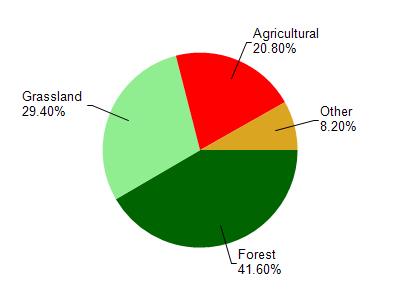Iowa
Yes
No
No
Fish and Aquatic Life
Overview
Big Rock Branch is a Class II trout stream tributary to the Blue River. It has been recommended that 2.5 miles in Iowa County be upgraded to a Class I trout fishery and an exceptional resource water (ERW). The Iowa County portion of the stream has some natural reproduction of brook trout while the Grant County portion has some natural reproduction of brown trout. Big Spring Branch has been ranked as a high priority for nonpoint source pollution reduction. Grazing and large barnyards along the stream are thought to be a major contributing source of nonpoint pollution to the stream.
Date 2001
Author Aquatic Biologist
Historical Description
From: Smith, Tom D., and Ball, Joseph R., Lake and Stream Classification Project. Surface Water Resources of Grant County, Department of Natural Resources, 1972. Surface Area = 2.1B acres, Length = 3.0 miles, Gradient = 33 ft./mile, Flow = 0.5 c.f.s.
It is one of the eight spring-fed trout streams flowing into the Blue River in northeastern Grant County. The stream begins near the Iowa and Grant County line and flows northwest entering the Blue River three miles east of Castle Rock. It flows through very picturesque country characterized by rock outcrops and giant boulders. Large boulder-strewn pools with narrow riffles are common. Brown, brook and rainbow trout are found throughout the stream with the best trout water being located in the lower reaches. It only receives a moderate amount of fishing pressure. Natural reproduction of both brown and brook trout is found in this stream. Forage species are also common. A floodwater detention structure is scheduled to be constructed about one mile above the mouth as part of the Blue River P.L. 566 Watershed Project. When completed this structure should aontrol rapid runoff and lessen the damage to stream habitat. Aquatic game assets are restricted to a few muskrats and mink. Upland game varieties common to Grant County are found in the lands surrounding the stream. Public access is only possible from one bridge crossing in the lower reaches. Three dwellings are found along the banks.
Date 1972
Author Surface Water Inventory Of Wisconsin
Historical Description
Big Rock Branch - Location of mouth T6N R1E Section 4 -3, Surface Area = 0.3 acres, Length = 0.5 miles, Gradient = 47.5 feet per mile, Total alkalinity = 260.0 mg/l, Volume of flow = 0.3 cfs. Most of the stream is intermittent within Iowa County and so its length is short. Most of its streambanks are heavily eroded in Iowa County. The permanent stream starts from a good spring. There is a sizable forage fish population consisting of sculpins, creek chubs, brook sticklebacks, stoneroller minnows, redbelly dace and johny darters. Trout are found in its lower sections, in Grant County. There is no land along its banks in public ownership at the present time and the only access is from a town road crossing.
From: Piening, Ronald and Threinen, C.W., 1968. Lake and Stream Classification Project. Surface Water Resources of Iowa County, Wisconsin Department of Natural Resources, Madison, WI.
Date 1968
Author Surface Water Inventory Of Wisconsin
Condition
Wisconsin has over 84,000 miles of streams, 15,000 lakes and milllions of acres of wetlands. Assessing the condition of this vast amount of water is challenging. The state's water monitoring program uses a media-based, cross-program approach to analyze water condition. An updated monitoring strategy (2015-2020) is now available. Compliance with Clean Water Act fishable, swimmable standards are located in the Executive Summary of Water Condition in 2018. See also the 'monitoring and projects' tab.
Reports
Management Goals
Wisconsin's Water Quality Standards provide qualitative and quantitative goals for waters that are protective of Fishable, Swimmable conditions [Learn more]. Waters that do not meet water quality standards are considered impaired and restoration actions are planned and carried out until the water is once again fishable and swimmable
Management goals can include creation or implementation of a Total Maximum Daily Load analysis, a Nine Key Element Plan, or other restoration work, education and outreach and more. If specific recommendations exist for this water, they will be displayed below online.
Monitoring
Monitoring the condition of a river, stream, or lake includes gathering physical, chemical, biological, and habitat data. Comprehensive studies often gather all these parameters in great detail, while lighter assessment events will involve sampling physical, chemical and biological data such as macroinvertebrates. Aquatic macroinvertebrates and fish communities integrate watershed or catchment condition, providing great insight into overall ecosystem health. Chemical and habitat parameters tell researchers more about human induced problems including contaminated runoff, point source dischargers, or habitat issues that foster or limit the potential of aquatic communities to thrive in a given area. Wisconsin's Water Monitoring Strategy was recenty updated.
Grants and Management Projects
Monitoring Projects
| WBIC | Official Waterbody Name | Station ID | Station Name | Earliest Fieldwork Date | Latest Fieldwork Date | View Station | View Data |
|---|
| 1213200 | Big Rock Br | 10042268 | Big Rock Branch US of CTH I | 1/1/2015 | 1/1/2015 | Map | Data |
|

Watershed Characteristics
Big Rock Br is located in the Blue River watershed which is 216.19 mi². Land use in the watershed is primarily forest (41.60%), grassland (29.40%) and a mix of agricultural (20.80%) and other uses (8.20%). This watershed has 513.46 stream miles, 416.83 lake acres and 5,825.06 wetland acres.
Nonpoint Source Characteristics
This watershed is ranked High for runoff impacts on streams, Not Ranked for runoff impacts on lakes and High for runoff impacts on groundwater and therefore has an overall rank of High. This value can be used in ranking the watershed or individual waterbodies for grant funding under state and county programs.However, all waters are affected by diffuse pollutant sources regardless of initial water quality. Applications for specific runoff projects under state or county grant programs may be pursued. For more information, go to surface water program grants.